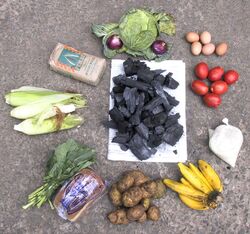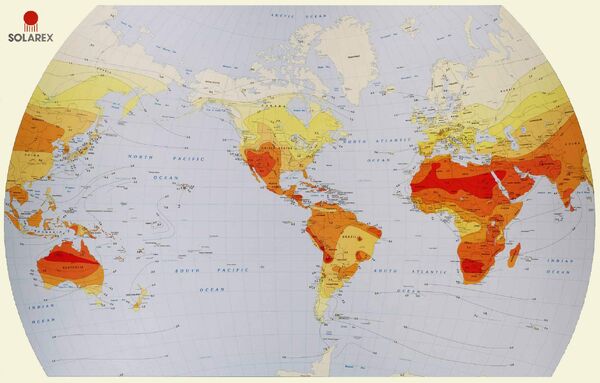|
Last edited: 18 May 2023
|
General guidelines[]
[Text borrowed from https://energypedia.info/wiki/Cooking_with_the_Sun#Basic_Rules_on_Dissemination_and_Use_of_Solar_Cookers]
- Suitable for local dishes: It must be possible to prepare the most important local dishes on the cooker, and solar cooking must not get in the way of local cooking traditions. For instance, one of the reasons solar cooker did not succeed in India was that cooking is considered a private activity, which is not done outside. Furthermore, local dishes frequently require frying or steaming, and such dishes are difficult to prepare in a box cooker.
- Easy handling: Handling (especially tracking the sun) must be easy for the user, and the cooker must be stable.
- Sufficient sunlight: The climate should be favourable for using solar cookers. There should be a time of year when the sun shines every day, making solar cooking a reliable option. A climate with frequent showers at any time of the year makes the use of certain types of solar cookers more difficult.
- Right exposure to sunlight: There must be places within the living area positioned favourably for capturing sunlight, enabling solar cooking to take place. Whilst this is not generally a problem in rural areas, it may limit the use in large cities.
- Biomass fuel costly (time, money): Solar cooking is likely to succeed only where biomass is scarce and difficult to gather, at least during part of the year. This condition holds true for both Tibet and the Bolivian Altiplano, where solar cookers have been successful.
- No subsidised modern fuel: The target group does not have easy access to other, reduced-price energy sources. For instance, subsidies for electricity were considered to be one reason for the failure of commercial distribution of solar cookers in South Africa.
- Solar cookers never “stand alone” solution: Cookers should never be offered as an individual solution, but ideally as a package with other energy-saving household technologies. This strategy partly contributed to the success of solar cookers in Bolivia where they have been offered in combination with energy-efficient stoves and other low energy technologies.
- Good availability, affordability and maintenance: Cookers with a good price-performance ratio must be locally available, and after-sales service and maintenance must be assured.
- After sales services and follow-up: Thorough follow-up support for users must be provided, and structures to provide this have to be put in place during the project period. Comprehensive and thorough customer aftercare is essential for solar cookers. Especially at the beginning, people often operate them incorrectly, and falsely attribute their failure to the quality of the device. This quickly leads to the technology being rejected. To solve this problem, it is important for a contact person to be locally available. In Tibet, this was a problem during the beginning of solar cooker dissemination.
- Safe storage: In some areas the cooker must be protected against theft and should therefore be easy to move to a safe place. This can be a costly barrier for poor households.
- Promotion of additional functions: Dissemination of solar cookers should stress their important additional functions, depending on the situation – for example sterilising drinking water, preserving jams or fruits, heating clothes irons, etc.
Climates that are mostly dry and sunny[]
- Solar cooking is most useful where there are a few hours midday at least six months of the year without rain, clouds, fog or dust storms.
Deforestation and fuel scarcities[]

In a Nairobi, Kenya market each pile of food items costs the same as the pile of charcoal in the center of the circle. By using a CooKit or other solar cooker, people can buy food instead of fuel.
- Cost: Families spend a large part of their income for cooking fuels that were once free or very cheap.
- Labor: Many hours are spent gathering fuel from ever-longer distances. Children miss school to gather fuel.
- Nutrition: Diets altered by insufficient cooking fuel cause malnutrition. For example, families reduce cooking to one meal a day or less, or barter food for fuel, or turn away from nutritious foods like beans, which require long hours of cooking.
Health and safety problems[]
- Diseases: Widespread intestinal diseases cause child deaths from unsafe drinking water. Many suffer lung and eye diseases from smoke.
- Injuries: Injuries from carrying heavy loads of fuel are common. Children suffer serious burns from open fires.
- Main article: Health and safety
Other factors favoring solar cooking[]
- Cooking is already done outside and there are sunny areas where the cooker(s) and food can safely be left unattended.
- Black cooking pots are already commonly used or aluminum pots with black paint.
- Main meal(s) are at noon or later in the day or soon after sunset. See Heat storage.
- Fires require constant attention to prevent food from burning.
- Fires create soot requiring a lot of pot scrubbing and add heat to cooking areas on hot days
Factors that accelerate spread and use[]
- Training and ongoing follow-up is essential.
- Transportation and communication systems are adequate to distribute supplies (it is easier to promote in cities and towns than remote rural villages).
- A strong retailer distribution network helps.
- Political stability is sufficient to allow people to travel and exchange information.
- Gender roles allow/encourage women to participate in community groups and have some say in family financial matters.
- Few families are employed in wood gathering, making charcoal or selling other fuels.
- Public policies encourage – or at least not impede – sustainable technologies like solar cooking.
- Local businesses or women’s organizations want to promote solar cooking and endorse local efforts.
- Venture capital is available. This can be difficult as many funders expect dramatic results in unreasonably short times of two to five years. Costs of start-up and spreading public awareness are often high in new areas.
The 25 countries with the greatest potential[]
Solar Cookers International lists these top 25 countries by the order of their solar cooking potential:
- India
- China
- Pakistan
- Ethiopia
- Nigeria
- South Africa
- Brazil
- Uganda
- Tanzania
- Afghanistan
- Sudan
- Nepal
- Kenya
- Somalia
- Niger
- Mozambique
- Burkina Faso
- Haiti
- Madagascar
- Malawi
- Zimbabwe
- Sri Lanka
- Eritrea
- Dominican Republic
- Zambia
- Main article: The 25 countries with the most solar cooking potential.

